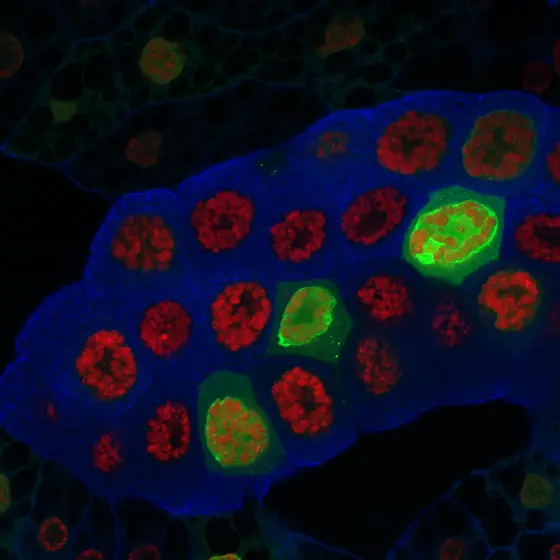Endocycles are very common in nature: They fuel growth in many invertebrates such as mollusks, insects or crustaceans and also in plants. Endocycles are responsible for generating up to half of Earth’s biomass. Promoting or suppressing endocycles from outside might have important economic implications. Thus, just one extra endocycle in the cells of a crop plant would double the agricultural yield from that crop, while one endocycle less in an insect pest could make it controllable. Nevertheless, this type of cell cycle has been little investigated up to now and, unlike cell division, or mitosis, has not been completely understood.
The team of Bruce Edgar, who leads a joint department of DKFZ and the Center for Molecular Biology of Heidelberg University (ZMBH) in an alliance of the two institutes, has now found out that the mechanics behind this cell cycle are very similar to those of mitosis. In both processes, a cycle of production and destruction of particular proteins is responsible for DNA replication and, thus, replication of all other cellular components, being initiated at regular intervals and stopped again after its completion.
“We have found out that the two factors E2F and CRL4 play an important role in this process," said first author Norman Zielke. “E2F starts the endocycle and is subsequently destroyed by CRL4. Then CRL4 becomes inactive and E2F can slowly accumulate again. When its concentration is high enough, the cycle repeats itself." The scientists also found that the faster the E2F concentration reaches its threshold, the faster the next cycle starts and the faster the cell grows. The function of E2F is similar to the function of mitotic cyclins, which regulate cell division (mitosis).
“A number of studies have shown that the E2F and CRL4 proteins also play a role in normal cell division (mitosis)," said Edgar, pointing to the medical relevance of their findings. “Any defects in this process result in severe DNA damage and we therefore suspect that these two factors also play a role in the development of cancer."
For their research, the investigators used the fruit fly, Drosophila. The cells in its saliva glands endoreplicate about 10 times and, thus, grow 1,000-fold their initial size. Humans, too, have several cells that endocycle: heart muscle cells; certain types of blood cells; megakaryocytes, which – as their name suggests – are very large; and the cells in the placenta that feed the embryo. Bruce Edgar and colleagues now aim to find out whether endocycling in these cells is also controlled by the two proteins, E2F and CRL4.
Norman Zielke, Kerry J. Kim, Vuong Tran, Shusaku T. Shibutani, Maria-Jose Bravo, Sabarish Nagarajan, Monique van Straaten, Brigitte Woods, George von Dassow, Carmen Rottig, Christian F. Lehner, Savraj Grewal, Robert J. Duronio, and Bruce A. Edgar: Control of Drosophila endocycles by E2F and CRL4Cdt2, DOI 10.1038/nature10579.
